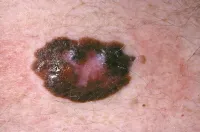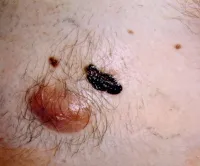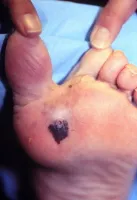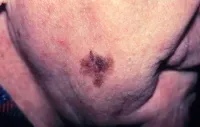Last medically reviewed on June 12, 2019
Survival Rates for Different Types of Skin Cancer
Skin cancer is the abnormal growth of skin cells. It’s a common cancer that can form on any part of the body, but it often occurs on sun-exposed skin.
The sun’s ultraviolet (UV) rays can damage the DNA in your skin cells over time, resulting in the growth of cancerous cells.
Anyone can get skin cancer, but some things can increase a person’s risk. Risk factors include having:
- lighter skin
- a history of sunburns
- a personal or family history of skin cancer
Skin cancer survival rates vary depending on the type of cancer. Some types of skin cancer are life-threatening when not treated early, while others have a low death rate.
The four most common types of skin cancer include:
Melanoma
Melanoma is skin cancer that forms in melanocytes. These are the skin cells that produce melanin, a pigment responsible for skin color.
Melanoma is the most dangerous type of skin cancer, but it’s also a less common type.
Melanoma skin cancer usually presents as a brown or black spot that’s larger than a mole.
The spot or bump can have an irregular border and shades of different colors. The bump might be reddish in color with black, blue, or purple spots mixed in.
Melanoma can develop anywhere on the body, such as the:
- chest
- back
- legs
- soles of the feet
- underneath the nails
Basal cell carcinoma
Basal cell carcinoma is the most common type of skin cancer. It accounts for more than 80 percent of skin cancer diagnoses.
It forms in the basal cells and is found on parts of the body heavily exposed to the sun. Although basal cell carcinoma grows slowly and doesn’t usually spread to surrounding areas, it can be life-threatening if left untreated.
Symptoms of basal cell carcinoma include:
- flat white or yellowish area
- raised red patches
- pink or red shiny bumps
- pink growths with raised edges
- open sore that doesn’t heal
Squamous cell carcinoma
Squamous cell carcinoma also has a low death rate. It’s slow-growing and can develop on the:
- rough, scaly red patches
- raised bumps or lumps with a slight indentation in the center
- open sores that don’t heal
- wartlike growths
Merkel cell carcinoma
Merkel cell carcinoma starts in the Merkel cells. These are located below the top layer of skin near the nerve endings.
It’s an aggressive type of skin cancer that’s difficult to treat, but it’s rare. It’s more likely to occur in people older than 50 and those with a weaker immune system.
Merkel cell carcinoma is fatal if it spreads to the brain, lungs, liver, or bones.
An early sign of Merkel cell carcinoma is a fast-growing flesh-colored bump or nodule that may bleed. Nodules can also be red, blue, or purple.
If you receive a skin cancer diagnosis, the next step is to identify its stage.
Staging is how doctors determine whether the cancer has spread to other parts of your body. Staging is common with melanoma and Merkel cell carcinoma, because these cancers are more likely to spread.
Typically, basal cell and squamous cell carcinomas don’t involve staging. These skin cancers are easily treated and don’t usually spread. However, your doctor may recommend staging for larger lesions.
Staging is based on the size of the growth and whether it has high-risk features. High-risk features include:
- larger than 2 millimeters thick
- spreads into the lower levels of the skin
- spreads into the space around a nerve
- appears on the lips or ears
- appears abnormal under a microscope
Here’s a general breakdown of skin cancer stages:
- Stage 0. The cancer hasn’t spread to surrounding areas of the skin.
- Stage 1. The cancer is 2 centimeters (cm) across or less, with no high-risk features.
- Stage 2. The cancer is more than 2 cm across and has a least two high-risk features.
- Stage 3. The cancer has spread to the bones in the face or nearby lymph nodes.
- Stage 4. The cancer has spread to the lymph nodes or internal organs.
The outlook, or survival rate, for skin cancer depends on the type of skin cancer and stage of cancer at diagnosis.
Typically, the earlier you receive a diagnosis with skin cancer, the better your outcome. Cancer is harder to treat once it spreads to other parts of the body.
Melanoma survival rate
Melanoma is a deadly cancer when it spreads, but it’s curable in its early stages.
The five-year survival rate for melanoma stages 0, 1, and 2 is 98.4 percent, according to the Melanoma Research Alliance.
The five-year survival rate of stage 3 melanoma is 63.6 percent. It’s 22.5 percent for stage 4 melanoma.
Merkel cell survival rate
According to the American Cancer Society , the five-year survival rate for Merkel cell stages 0, 1, and 2 is 78 percent. It’s 51 percent for stage 3 and 17 percent for stage 4.
Basal cell and squamous cell survival rates
Because basal cell and squamous cell carcinomas are lower-risk skin cancers, there’s little information on survival rates based on stage.
Both types of cancer have a very high cure rate. According to the Canadian Cancer Society, the five-year survival rate for basal cell carcinoma is 100 percent. The five-year survival rate for squamous cell carcinoma is 95 percent.
Skin cancer is a very preventable cancer. Here’s how to protect yourself when outdoors:
- Use sunscreen with an SPF of at least 30 or higher. Follow product instructions and reapply as needed.
- Wear sunglasses.
- Wear a wide-brimmed hat to protect your face, head, ears, and neck.
- Wear pants and long sleeves to protect your arms and legs.
- Stay in the shade when possible.
- Avoid indoor tanning.
- Avoid the sun during the middle of the day when it’s at its strongest.
- Tell your doctor of any new skin growths or changes to moles, bumps, or birthmarks.
Once a skin biopsy confirms skin cancer, your doctor will recommend a treatment based on the stage of the cancer.
To improve your outlook, it’s important that you complete your treatment and schedule follow-up appointments as needed. Your doctor may want to see you every few months to make sure the cancer hasn’t returned.
Also schedule annual skin exams with a dermatologist. Get into the habit of checking your own skin for abnormal growths, too. This includes your back, scalp, soles of feet, and ears.
You can also ask your doctor about local support groups for those with skin cancer, or search for support programs in your area .
Depending on the type, skin cancer can grow rapidly and become life-threatening if not treated early.
Talk to your doctor if you have any new growths on your skin or notice changes to an existing mole, bump, or birthmark.
Skin cancer has a high cure rate, but only if caught early.
Last medically reviewed on June 12, 2019
Skin Cancer
Skin cancer is the most common of all human cancers. In 2022, about 100,000 people in the U.S. are expected to be diagnosed with some type of the disease. About 7,650 are expected to die.
Cancer occurs when normal cells undergo a transformation and grow and multiply without normal controls. Here are the cancer basics:
- As the cells multiply, they form a mass called a tumor.
- Tumors are cancerous only if they are malignant. This means that they encroach on and invade neighboring tissues (especially lymph nodes) because of their uncontrolled growth.
- Tumors may also travel to remote organs via the bloodstream. This process of invading and spreading to other organs is called metastasis.
- Tumors overwhelm surrounding tissues by invading their space and taking the oxygen and nutrients they need to survive and function.
There are three major types of skin cancers: basal cell carcinoma (BCC), squamous cell carcinoma (SCC), and melanoma. The first two skin cancers are grouped together as non-melanoma skin cancers. Other unusual types of skin cancer include Merkel cell tumors and dermatofibrosarcoma protruberans.
Here are the basics on skin cancers:
- The vast majority of skin cancers are basal cell carcinomas and squamous cell carcinomas. While malignant, these are unlikely to spread to other parts of the body if treated early. They may be locally disfiguring if not treated early.
- A small but significant number of skin cancers are malignant melanomas. Malignant melanoma is a highly aggressive cancer that tends to spread to other parts of the body. These cancers may be fatal if not treated early.
Like many cancers, skin cancers start as precancerous lesions. These precancerous lesions are changes in skin that are not cancer, but could become cancer over time. Medical professionals often refer to these changes as dysplasia. Some specific dysplastic changes that occur in skin are as follows:
- Actinic keratosis is an area of red or brown, scaly, rough skin, which can develop into squamous cell carcinoma.
A nevus is a mole, and abnormal moles are called dysplastic nevi. These can potentially develop into melanoma over time. - Moles are simply growths on the skin that rarely develop into cancer. Most people have 10 to 30 moles on their body that can be identified as flat or raised, smooth on the surface, round or oval in shape, pink, tan, brown or skin-colored, and no larger than a quarter-inch across. If a mole on your body looks different from the others, ask your health care provider to take a look at it.
Recent studies show the number of skin cancer cases in the U.S. growing at an alarming rate. Fortunately, increased awareness on the part of Americans and their health care providers has resulted in earlier diagnosis and improved outcomes.
Continued
Skin Cancer Causes
Ultraviolet (UV) light exposure, most commonly from sunlight, is overwhelmingly the most frequent cause of skin cancer.
Other important causes of skin cancer include the following:
- Use of tanning booths
- Immunosuppression, or impairment of the immune system
- Exposure to unusually high levels of radiation, such as from X-rays
- Contact with certain chemicals, such as arsenic (miners, sheep shearers, and farmers) and hydrocarbons in tar, oils, and soot (which may cause squamous cell carcinoma)
The following people are at the greatest risk of skin cancer:
- People with fair skin, especially types that freckle, sunburn easily, or become painful in the sun
- People with light (blond or red) hair and blue or green eyes
- Those with certain genetic disorders that deplete skin pigment , such as albinism and xeroderma pigmentosum (a disease in which DNA repair mechanisms, especially in response to ultraviolet light, is impaired)
- People who have already been treated for skin cancer
- People with numerous moles, unusual moles, or large moles that were present at birth
- People with close family members who have developed skin cancer
- People who had at least one severe sunburn early in life
- People with burns unrelated to sunburn
- People with indoor occupations and outdoor recreational habits
Basal cell carcinomas and squamous cell carcinomas are more common in older people. Melanomas are one of the most common cancers in younger people, especially in people ages 25 to 29. The risk of melanoma rises with age.
Skin Cancer Symptoms
Skin cancer symptoms depend on the type of skin cancer that has developed.
A basal cell carcinoma (BCC) usually looks like a raised, smooth, pearly bump on the sun-exposed skin of the head, neck, or shoulders. Others signs include:
- Small blood vessels may be visible within the tumor.
- A central depression with crusting and bleeding (ulceration) frequently develops.
- A BCC often appears as a sore that does not heal.
A squamous cell carcinoma (SCC) is commonly a well-defined, red, scaling, thickened bump on sun-exposed skin. It may ulcerate and bleed, and left untreated, may develop into a large mass.
The majority of malignant or cancerous melanomas are brown-to-black pigmented lesions. Other signs of a cancerous melanoma include:
- A change in size, shape, color, or elevation of a mole
- The appearance of a new mole during adulthood, or new pain, itching, ulceration, or bleeding of an existing mole
Continued
The following easy-to-remember guideline, “ABCDE,” is useful for identifying malignant melanoma:
- Asymmetry — One side of the lesion does not look like the other.
- Border irregularity — Margins may be notched or irregular.
- Color — Melanomas are often a mixture of black, tan, brown, blue, red, or white.
- Diameter — Cancerous lesions can be larger than 6 mm across (about the size of a pencil eraser), although with early detection they will not reach this size.
- Evolution — has a mole changed over time?
When to Seek Medical Care for Skin Cancer
Many people, especially those who have fair coloring or have had extensive sun exposure, periodically check their entire body for suspicious moles and lesions.
Have your primary health care provider or a dermatologist check any moles or spots that concern you.
See your health care provider to check your skin if you notice any changes in the size, shape, color, or texture of pigmented areas (such as darker or a change in areas of skin or moles).
If you have skin cancer, your skin specialist (dermatologist) or cancer specialist (oncologist) will talk to you about symptoms of metastatic disease that might require care in a hospital.
Exams and Tests for Skin Cancer
If you think a mole or other skin lesion has turned into skin cancer, your primary care provider will probably refer you to a dermatologist. The dermatologist will examine any moles in question and, in many cases, the entire skin surface. Any lesions that are difficult to identify, or are thought to be skin cancer, may then be checked. Tests for skin cancer may include:
- The doctor may use a handheld device called a dermatoscope to scan the lesion. Another handheld device, MelaFind, scans the lesion then a computer program evaluates images of the lesion to indicate if it’s cancerous.
- A sample of skin (biopsy) will be taken so that the suspicious area of skin can be examined under a microscope.
- A biopsy is done in the dermatologist’s office.
If a biopsy shows that you have malignant melanoma, you may undergo further testing to determine the extent of spread of the disease, if any. This may involve blood tests, a chest X-ray, and other tests as needed. This is only needed if the melanoma is of a certain size.
Continued
Skin Cancer Treatment
Skin cancer treatment for basal cell carcinoma and squamous cell carcinoma is straightforward. Usually, surgical removal of the lesion is adequate. Malignant melanoma, however, may require several treatment methods — depending on the size of the tumor — including surgery, radiation therapy, immunotherapy, and chemotherapy. Because of the complexity of treatment decisions, people with malignant melanoma may benefit from the combined expertise of the dermatologist, a cancer surgeon, and an oncologist.
Skin Cancer Care at Home
Home treatment is not appropriate for skin cancer. These conditions require the care of a dermatologist or specialist in skin cancers.
Be active in preventing and detecting skin cancer on yourself and others. Perform regular self-examinations of your skin and note any changes.
Medical Treatment for Skin Cancer
Surgical removal is the mainstay of skin cancer treatment for both basal cell and squamous cell carcinomas. For more information, see Surgery.
People who cannot undergo surgery may be treated by external radiation therapy. Radiation therapy is the use of a small beam of radiation targeted at the skin lesion. The radiation kills the abnormal cells and destroys the lesion. Radiation therapy can cause irritation or burning of the surrounding normal skin. It can also cause fatigue. These side effects are temporary. In addition, topical chemotherapy creams have been FDA approved for the treatment of certain low-risk nonmelanoma skin cancers. Patients with advanced or many basal cell carcinomas are sometimes prescribed oral pills to block the growth of these cancers. Side effects include muscle spasms, hair loss, taste changes, weight loss and fatigue.
In advanced cases of melanoma, immune therapies, vaccines, or chemotherapy may be used. These treatments are typically offered as clinical trials. Clinical trials are studies of new therapies to see if they can be tolerated and work better than existing therapies.
Surgery for Skin Cancer
Small skin cancer lesions may be removed through a variety of techniques, including simple excision (cutting it away), electrodesiccation and curettage (scraping the tumor and then burning the tissue with an electric needle), and cryosurgery (freezing the area with liquid nitrogen).
Larger tumors, lesions in high-risk locations, recurrent tumors, and lesions in cosmetically sensitive areas are removed by a technique called Mohs micrographic surgery. For this technique, the surgeon carefully removes tissue, layer by layer, until cancer-free tissue is reached.
Malignant melanoma is treated more aggressively than just surgical removal. To ensure the complete removal of this dangerous malignancy, 1-2 cm of normal-appearing skin surrounding the tumor is also removed. Depending on the thickness of the melanoma, neighboring lymph nodes may also be removed and tested for cancer. The sentinel lymph node biopsy method uses a mildly radioactive substance to identify which lymph nodes are most likely to be affected.
Continued
After Skin Cancer Treatment
Most skin cancer is cured surgically in the dermatologist’s office. Of skin cancers that do recur, most do so within three years. Therefore, follow up with your dermatologist as recommended. Make an appointment immediately if you suspect a problem.
If you have advanced malignant melanoma, your oncologist may want to see you every few months. These visits may include total body skin exams, regional lymph node checks, and periodic chest X-rays and body scans. Over time, the intervals between follow-up appointments will increase. Eventually these checks may be done only once a year.
Skin Cancer Prevention
You can reduce your risk of getting skin cancer by following these guidelines:
- Limit sun exposure. Attempt to avoid the sun’s intense rays between 10 a.m. and 4 p.m.
- Apply sunscreen every day. Use a sunscreen with sun protection factor (SPF) of at least 30 both before and every 60 to 80 minutes during outdoor exposure. Select products that filter both UVA and UVB light. The label will tell you.
- If you are likely to sunburn, wear a long-sleeved shirt, pants and a wide-brimmed hat.
- Avoid artificial tanning booths.
- Conduct monthly self-exams.
Skin Self-Exams
Monthly skin self-exams improve your chances of finding a skin cancer early, when it has done a minimum of damage to your skin and can be treated easily. Regular self-exams help you recognize any new or changing features.
- The best time to do a self-exam is right after a shower or bath.
- Do the self-exam in a bright room; use a full-length mirror and a hand-held mirror.
- Learn where your moles, birthmarks, and blemishes are, and what they look like.
- Each time you do a self-exam, check these areas for changes in size, texture, and color, and for ulceration. If you notice any changes, call your primary care provider or dermatologist.
Check all areas of your body, including “hard-to-reach” areas. Ask a loved one to help you check if there are areas you can’t see.
- Look in the full-length mirror at your front and your back (use the hand-held mirror to do this). Raise your arms and look at your left and right sides.
- Bend your elbows and look carefully at your palms, nails, forearms (front and back), and upper arms.
- Examine the backs and fronts of your legs. Look at your buttocks (including the area between the buttocks) and your genitals (use the hand-held mirror to make sure you see all skin areas).
- Sit down and examine your feet carefully, including the nails, soles and between the toes.
- Look at your scalp, face, and neck. You may use a comb or blow dryer to move your hair while examining your scalp. You may also enlist the help of a friend or family member.
If you are at high risk for developing skin cancer, ask you doctor about oral nicotinamide, a vitamin B3 supplement taken twice daily in pill form that can decrease the rate of new squamous cell and basal cells by almost 25%.
Continued
Skin Cancer Outlook
Although the number of skin cancers in the U.S. continues to rise, more skin cancers are being caught earlier, when they are easier to treat. Thus, illness and death rates have decreased.
When treated properly, the cure rate for both basal cell carcinoma (BCC) and squamous cell carcinoma (SCC) approaches 95%. The remaining cancers recur at some point after treatment.
- Recurrences of these cancers are almost always local (not spread elsewhere in the body), but they often cause significant tissue destruction.
- 2% of squamous cell carcinomas will eventually spread elsewhere in the body and turn into dangerous cancer. Metastatic squamous cell carcinoma of the skin is usually seen in people with compromised immune systems.
In most cases, the outcome of malignant melanoma depends on the thickness of the tumor at the time of treatment.
- Thin lesions are almost always cured by simple surgery alone.
- Thicker tumors, which usually have been present for some time but have gone undetected, may spread to other organs. Surgery removes the tumor and any local spread, but it cannot remove distant metastasis. Other therapies, such as radiation therapy, immunotherapy or chemotherapy, are used to treat the metastatic tumors.
- Malignant melanoma causes more than 75% of deaths from skin cancer.
Skin Cancer Support Groups and Counseling
Living with skin cancer presents many new challenges for you and for your family and friends. You will probably have many worries about how the cancer will affect you and your ability to “live a normal life,” that is, to care for your family and home, to hold your job, and to continue the friendships and activities you enjoy.
Many people with a skin cancer diagnosis feel anxious and depressed. Some people feel angry and resentful; others feel helpless and defeated. For most people with skin cancer, talking about their feelings and concerns helps. Your friends and family members can be very supportive. They may be hesitant to offer support until they see how you are coping. Don’t wait for them to bring it up. If you want to talk about your concerns, let them know.
Continued
Some people don’t want to “burden” their loved ones, or prefer talking about their concerns with a more neutral professional. A social worker, counselor, or member of the clergy can be helpful. Your dermatologist or oncologist should be able to recommend someone.
Many people with cancer are profoundly helped by talking to other people who have cancer. Sharing your concerns with others who have been through the same thing can be remarkably reassuring. Support groups for people with cancer may be available through the medical center where you are receiving your treatment. The American Cancer Society also has information about support groups throughout the U.S.
For More Information About Skin Cancer
National Cancer Institute, Cancer Information Service (CIS)
Toll-free: (800) 4-CANCER (800) 422-6237
TTY (for deaf and hard of hearing callers): (800) 332-8615
Skin Cancer Foundation
255 Lexington Avenue, 11th Floor
New York, NY 10016
(212)754-5176
Skin Cancer Web Links
For information about clinical trials in skin cancer treatment, visit the National Institute of Health’s Clinical Trials database. For other valuable information, visit the following websites:
Skin Cancer Pictures
Media file 1: Skin cancer. Malignant melanoma.

Media file 2: Skin cancer. Basal cell carcinoma.
Media file 3: Skin cancer. Superficial spreading melanoma, left breast. Photo courtesy of Susan M. Swetter, MD, Director of Pigmented Lesion and Cutaneous Melanoma Clinic, Assistant Professor, Department of Dermatology, Stanford University Medical Center, Veterans Affairs Palo Alto Health Care System.

Media file 4: Skin cancer. Melanoma on the sole of the foot. Diagnostic punch biopsy site located at the top. Photo courtesy of Susan M. Swetter, MD, Director of Pigmented Lesion and Cutaneous Melanoma Clinic, Assistant Professor, Department of Dermatology, Stanford University Medical Center, Veterans Affairs Palo Alto Health Care System.

Media file 5: Skin cancer. Melanoma, right lower cheek. Photo courtesy of Susan M. Swetter, MD, Director of Pigmented Lesion and Cutaneous Melanoma Clinic, Assistant Professor, Department of Dermatology, Stanford University Medical Center, Veterans Affairs Palo Alto Health Care System.
Continued

Media file 6: Skin cancer. Large sun-induced squamous cell carcinoma (skin cancer) on the forehead and temple. Image courtesy of Dr. Glenn Goldman.

WebMD Medical Reference Reviewed by Stephanie S. Gardner, MD on April 26, 2022
Sources
Photo Credit (inset, nose): Richard Usatine, MD
Photo Credit (inset, close-up): ©DermNet NZ / www.dermnetnz.org 2022
Photo Credit (inset, cheek): Richard Usatine, MD
News release, Mela Sciences. National Cancer Institute. American Cancer Society. FDA.
Cancer Treatment Centers of America – Photo Caption
American Osteopathic College of Dermatology – Photo Caption
Memorial Sloan Kettering Cancer Center – Photo Caption
National Library of Medicine – Photo Caption
National Cancer Institute – Photo Caption
DermNet NZ – Photo Caption
© 2022 WebMD, LLC. All rights reserved.
Next Article
Melanoma/ Skin Cancer Guide
- Overview
- Symptoms & Types
- Treatment & Care
- Support & Resources





